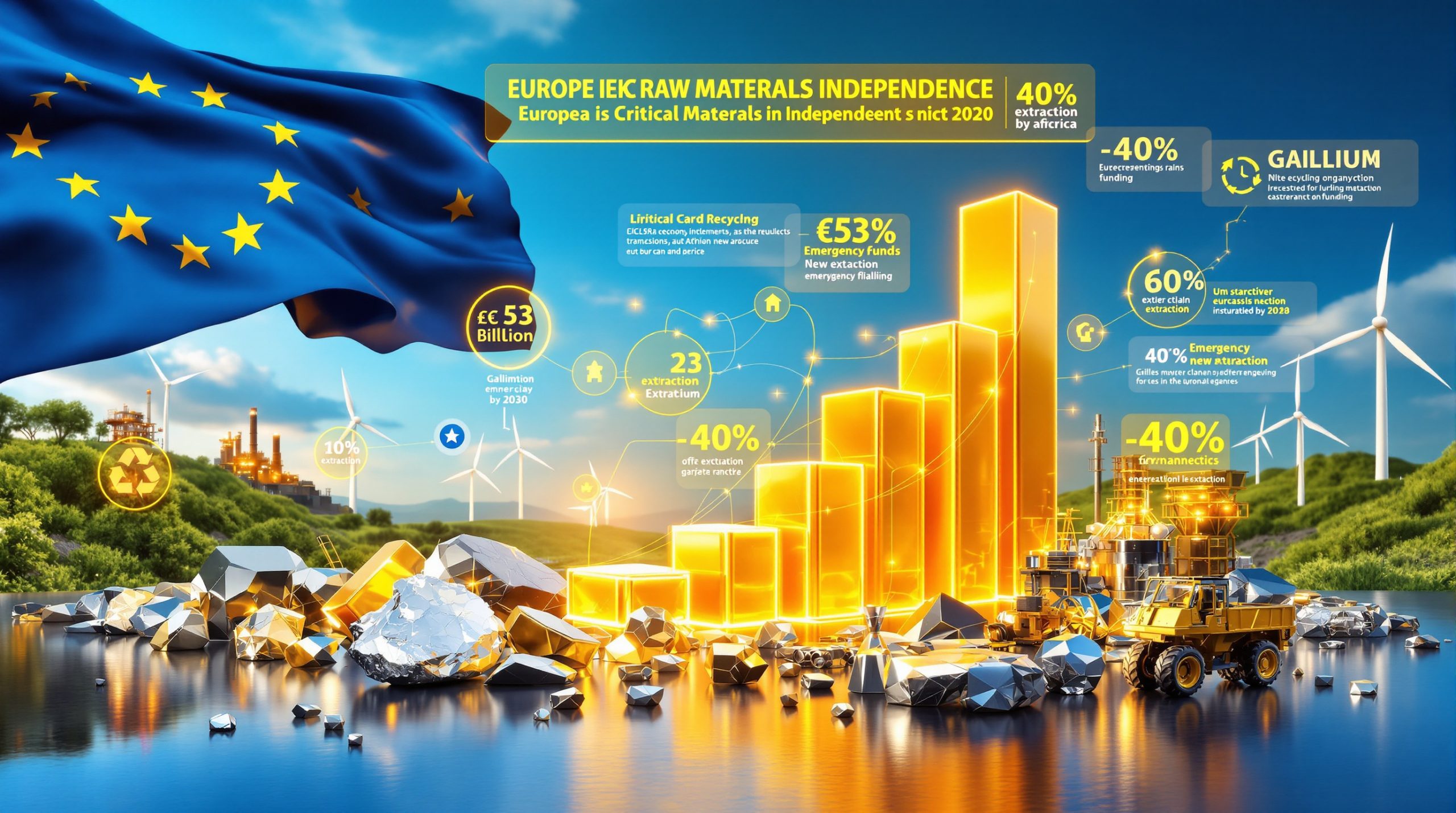South Africa's Rare Earth Extraction Revolution: Innovative Approaches for a Critical Minerals Future
South Africa is pioneering innovative approaches to rare earth extraction that could reshape global supply chains. Unlike traditional mining operations, these new methods focus on recovering rare earth elements (REEs) from existing waste materials, significantly reducing environmental impact while creating economically viable production pathways. This South Africa rare earth extraction innovation comes at a critical time when demand for these strategic minerals continues to surge worldwide.
The Phalaborwa project in Limpopo province stands as a prime example of this innovation, with recent laboratory tests achieving exceptional purity levels for extracted rare earths. According to Mining Weekly reports from September 2025, the project has successfully maintained a 65% REE recovery rate from phosphogypsum feed, demonstrating the commercial viability of this approach.
The Strategic Importance of Rare Earth Innovation
Rare earth elements are essential components in technologies driving the critical minerals energy transition, including electric vehicles, wind turbines, and advanced electronics. With global markets seeking alternatives to China's dominance in rare earth production, South Africa's innovative extraction methods could establish the country as a significant player in sustainable rare earth supply.
The timing couldn't be better, as Western nations increasingly recognize the strategic importance of developing alternative REE supply chains. Recent initiatives by the US, Australian, and European governments aim to improve the economics of rare earth projects and support financing to rapidly build out end-to-end rare earth permanent magnet supply chains.
What Makes South Africa's Phosphogypsum Extraction Approach Revolutionary?
Transforming Waste into Valuable Resources
The Phalaborwa project represents a paradigm shift in rare earth production. Rather than mining virgin ore, the project recovers rare earth elements from phosphogypsum stacks—waste byproducts from decades of phosphoric acid production. This approach eliminates many traditional mining challenges:
- No need for exploration, drilling, or blasting
- Elimination of crushing and grinding processes
- Reduced land disturbance and environmental footprint
- Lower capital requirements and faster path to production
The project targets 35 million tonnes of phosphogypsum resource accumulated over 60 years of phosphoric acid production by Foskor. This extensive resource provides a projected 16-year operational lifespan, during which approximately 150,000 tonnes of rare earth elements will be recovered.
Technical Breakthroughs in Processing
South African researchers have developed a proprietary hydrometallurgical process that achieves exceptional purity levels for extracted rare earths. As reported by Mining Weekly in September 2025, key innovations include:
- Continuous ion exchange (CIX) technology that maximizes REE recovery while rejecting impurities
- Novel combination of CIX and precipitation steps that simplifies separation
- Optimization of primary leach circuits to reduce power, reagent, and labor costs
- Achievement of 65% REE recovery rates from phosphogypsum feed
These technical breakthroughs have been validated through extensive large-scale repetitive batch testing with solution recycle, confirming the commercial viability of the process. The incorporation of CIX and simplified final separation of only two products is expected to result in modest capital expenditure (capex) and operational expenditure (opex) for this part of the circuit.
Which Rare Earth Elements is South Africa Targeting?
High-Value Critical Minerals
The South African projects focus primarily on four high-demand rare earth elements:
- Neodymium (Nd): Essential for permanent magnets in electric motors and wind turbines
- Praseodymium (Pr): Used in combination with neodymium in high-strength NdFeB magnets
- Dysprosium (Dy): Critical for improving temperature resistance in permanent magnets
- Terbium (Tb): Enhances coercivity in permanent magnets and used in solid-state devices
These elements command premium prices in global markets due to their critical role in green technologies and limited supply sources. A recent offtake agreement between the US Department of Defense and MP Materials utilized a floor price of $110/kg for neodymium and praseodymium (NdPr), demonstrating industry acceptance of prices significantly above current market rates to ensure new sources of supply.
How Does South Africa's Approach Compare to Traditional Rare Earth Mining?
Economic Advantages
The innovative South African extraction methods offer several economic benefits compared to conventional mining:
| Factor | Traditional Rare Earth Mining | South African Phosphogypsum Approach |
|---|---|---|
| Initial capital expenditure | High (new mine development) | Moderate (processing facility only) |
| Operating costs | High (mining, crushing, complex processing) | Among lowest globally (waste processing) |
| Time to production | 5-10+ years | 2-4 years |
| Resource security | Subject to geological uncertainty | Measured resource in existing stacks |
| Processing complexity | Multiple complex stages | Simplified extraction process |
Rainbow Rare Earths CEO George Bennett has noted that the operating expenses are expected to be "the lowest of any project in the West and probably even below that of projects in the East," positioning the Phalaborwa project as a hardy frontrunner at a time when many rare earth projects struggle to achieve profitability at current pricing levels.
Environmental Benefits
The environmental advantages are equally significant:
- Remediation of legacy waste: Processes existing phosphogypsum stacks that pose environmental risks
- Reduced radioactivity concerns: Lower levels of radioactive elements compared to many rare earth deposits
- Water management: Closed-circuit water systems with neutralization and reuse capabilities
- Rehabilitation potential: Cleaned gypsum can be safely redeposited on properly lined stacks
Mining Weekly reports that the Phalaborwa site includes two unlined gypsum stacks that present environmental hazards. The project aims to clean these up in an environmentally friendly manner, effectively turning an environmental liability into an economic asset.
What Technical Challenges Has South Africa Overcome?
Laboratory Optimization in Johannesburg
A key component of South Africa's rare earth extraction innovation has been the extensive laboratory work conducted in Johannesburg. This research has overcome several critical challenges:
- Developing selective leaching processes that target rare earths while minimizing impurity extraction
- Creating purification techniques that produce exceptionally clean rare earth concentrates
- Optimizing reagent usage to minimize chemical consumption and environmental impact
- Establishing process control parameters that maintain consistent recovery rates
The key delivery of a high-grade, low-impurity feed stream to the final separation process has been successfully achieved by Rainbow's in-house team. The purification process combining CIX and precipitation steps represents a novel combination in REE recovery and demonstrates the special intellectual property in REE extraction that the company has developed.
Scaling from Laboratory to Commercial Production
The transition from laboratory success to commercial viability has required:
- Construction and operation of pilot plants to validate laboratory findings
- Collaboration with research institutions like Mintek to refine processing techniques
- Trade-off studies to optimize capital and operating expenditures
- Development of intellectual property around novel extraction methods
Rainbow's large pilot plant was built in collaboration with Mintek, South Africa's Council for Mineral Technology, which derives its mandate from the Minerals Technology Act. This partnership has been crucial in developing a one-of-a-kind flowsheet that enables the commercial extraction of key rare earths from phosphogypsum.
What is the Market Potential for South Africa's Rare Earth Production?
Global Demand Context
South Africa's rare earth innovations come amid growing global demand for these critical minerals:
- Permanent magnet applications are projected to grow at 8-12% annually through 2030
- Electric vehicle production continues to accelerate globally
- Wind energy installations are expanding in many markets
- Defense and high-tech applications require secure, non-Chinese supply chains
Western nations are increasingly recognizing the strategic importance of rare earth elements used in permanent magnets vital to the functionality of many products that underpin twenty-first-century society, as well as emerging and advanced technologies.
Production Potential and Economic Impact
The Phalaborwa project alone demonstrates significant production potential:
- 35 million tonnes of phosphogypsum resource
- 16-year projected operational lifespan
- Approximately 150,000 tonnes of rare earth elements to be recovered
- Potential to be among the lowest-cost producers globally
With its high economic grade of rare earths in the gypsum stacks at Phalaborwa, the project stands to make a substantial contribution to global rare earth reserves distribution at a time when demand for these elements continues to grow.
How Does South Africa's Approach Address Environmental Concerns?
Sustainable Processing Innovations
Environmental sustainability has been integrated into South Africa's rare earth extraction approach:
- Reagent optimization: Minimizing chemical usage while maintaining recovery rates
- Waste management: Proper handling and storage of process residues
- Energy efficiency: Process designs that reduce power consumption
- Land rehabilitation: Potential improvement of previously disturbed areas
The project also benefits from existing infrastructure at the Phalaborwa site, including a high-voltage switchyard, power lines, and fencing, reflecting the advantages of brownfield project development over greenfield sites.
Regulatory Compliance and Standards
The projects are being developed to meet stringent environmental standards:
- Alignment with International Finance Corporation (IFC) environmental guidelines
- Implementation of lined storage facilities for processed materials
- Comprehensive environmental impact assessments
- Water management systems that prevent contamination of surrounding areas
The remediation of the two unlined gypsum stacks at Phalaborwa represents a significant environmental improvement, as these currently pose hazards that will be addressed through the project's operations.
What Collaborative Efforts are Driving South Africa's Rare Earth Innovation?
Public-Private Partnerships
South Africa's rare earth extraction breakthroughs have benefited from collaboration between:
- Private mining companies with expertise in mineral processing
- Research institutions like Mintek that provide technical support and validation
- Government agencies that facilitate regulatory approvals and strategic planning
- International partners interested in securing rare earth supply chains
The collaboration with Mintek has been particularly valuable, as this Council for Mineral Technology brings significant expertise and research capabilities to the project.
Knowledge Transfer and Capacity Building
These collaborative efforts are building South Africa's capacity in critical minerals processing:
- Development of specialized technical expertise in rare earth extraction
- Creation of intellectual property that can be applied to other resources
- Training of skilled personnel in advanced hydrometallurgical techniques
- Establishment of South Africa as a center of excellence in rare earth processing
Through these efforts, South Africa is positioning itself as a leader in innovative approaches to rare earth extraction and processing, with potential benefits extending well beyond the immediate economic gains of the Phalaborwa project.
How Do South Africa's Rare Earth Projects Compare Globally?
Competitive Positioning
Several factors position South Africa's rare earth projects favorably in the global landscape:
- Cost structure: Among the lowest operating costs of any Western rare earth project
- Environmental profile: Significantly reduced impact compared to traditional mining
- Product purity: Exceptionally clean rare earth concentrates suitable for high-tech applications
- Development timeline: Faster path to production than greenfield mining projects
The commercial recovery of REEs from phosphogypsum makes Rainbow something of a pioneer, with the potential to become a very low-cost producer of light and heavy REE, and one of the highest margin projects in development globally.
Strategic Significance
The strategic importance of these projects extends beyond South Africa:
- Contribution to supply chain diversification away from Chinese dominance
- Support for Western nations' critical minerals security objectives
- Demonstration of sustainable approaches to rare earth production
- Potential template for similar projects in other regions
The recent initiatives by the US, Australian, and European governments aimed at improving the economics of, and supporting the financing for, REE projects underscore the strategic importance of developing alternative supply sources for these critical minerals.
What are the Future Prospects for South Africa's Rare Earth Sector?
Expansion Potential
The initial success of phosphogypsum-based rare earth extraction opens possibilities for:
- Application of similar techniques to other phosphogypsum stacks globally
- Exploration of additional waste streams that may contain recoverable rare earths
- Development of downstream processing capabilities within South Africa
- Integration with broader mineral beneficiation in South Africa strategies
With the proof of concept established at Phalaborwa, the potential exists to replicate this approach at other sites with similar waste streams, both within South Africa and internationally.
Challenges and Opportunities
Key factors that will influence the sector's development include:
- Rare earth price stability and market growth
- Access to investment capital for commercial-scale facilities
- Continued technical optimization to improve economics
- Development of offtake agreements with end-users
The recent offtake agreement between the US Department of Defense and MP Materials demonstrates growing recognition of the need to secure rare earth supplies, even at premium prices, providing a favorable environment for the development of new projects like Phalaborwa.
FAQ: South Africa's Rare Earth Extraction Innovation
What makes South Africa's rare earth extraction approach different from traditional mining?
South Africa's innovative approach recovers rare earth elements from phosphogypsum waste stacks rather than mining new ore. This eliminates the need for traditional mining industry evolution activities like drilling, blasting, and crushing, while also addressing environmental legacy issues by processing existing waste materials.
Which rare earth elements are being recovered in South Africa?
The projects focus primarily on four high-value rare earth elements: neodymium (Nd), praseodymium (Pr), dysprosium (Dy), and terbium (Tb). These elements are particularly valuable for their use in permanent magnets essential for electric vehicles, wind turbines, and other green technologies.
How does the environmental impact compare to conventional rare earth mining?
The environmental footprint is significantly smaller than conventional mining operations. The process remediates existing waste stacks, uses closed-circuit water systems, deals with lower levels of radioactive elements, and can safely redeposit cleaned gypsum on properly lined stacks.
What is the economic advantage of South Africa's approach?
The approach offers among the lowest operating costs of any rare earth project outside China. It requires less capital investment than new mines, has a faster path to production, and works with an already-defined resource rather than facing geological uncertainty.
How does this innovation affect global rare earth supply chains?
South Africa's innovation could help diversify global rare earth supply chains currently dominated by China. The projects offer a more environmentally sustainable and potentially cost-competitive alternative source for critical rare earth elements used in green technologies and high-tech applications.
Further Exploration
Readers interested in learning more about rare earth breakthrough innovation can also explore related educational content from Steenkampskraal, which offers perspectives on developments in the mining and minerals processing sectors.
Ready to Capture the Next Major Mineral Discovery?
Stay ahead of the market with Discovery Alert's proprietary Discovery IQ model, which instantly notifies investors of significant ASX mineral discoveries and turns complex data into actionable insights. Understand why major discoveries like those mentioned can lead to exceptional returns by visiting Discovery Alert's dedicated discoveries page.




